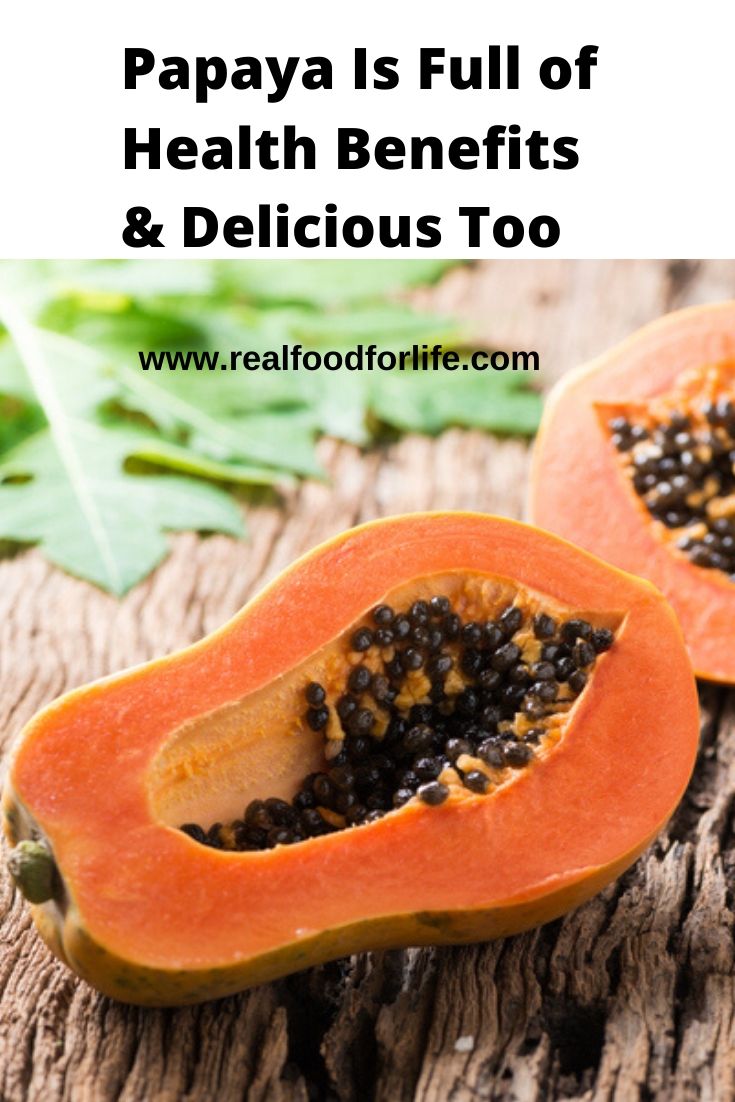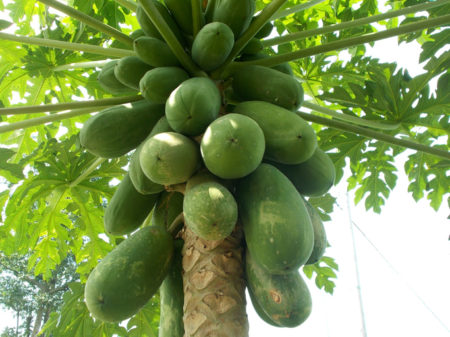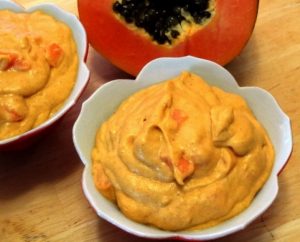Are you ready to learn about delicious sweet papaya, ‘the fruit of the angels’ which Christopher Columbus called it? It is full of many wonderful health benefits from helping digestion which it is famous for, to nourishing the skin and helping prevent cancer.
Also, learn how to choose the best papaya. that makes your taste buds dance with delight. It is known as the tree of health because the fruit, seed, root, stem, leaf, flower, peel and latex of the papaya are all used.
Once upon a time, it was an exotic and rare superfood fruit but now can be found almost all year.

6 Health Benefits of Papaya
Helps with Cancer Prevention
They are a good source of lycopene, which has been found to help reduce prostate, lung, pancreas, colon and rectum, esophagus, oral cavity, breast, cervix and stomach cancers according to studies.
Dried papaya leaf extract was found to have a very successful anticancer effect against lab-grown tumors (cancers of the breast, liver, lung cervix and pancreas). The results were stronger when the cancer cells received larger doses of the tea.
Good for Digestion
They contain the enzyme papain which helps the stomach in digesting protein, according to a study at the University of Illinois at Urbana-Champaign in 2011. Ripe papaya worked the best.
Also, it is used to treat a number of digestive issues such as intestinal problems, indigestion, constipation, and diarrhea.
Intestinal Parasites are Killed
It has been found that papaya seeds and fruit have anti-parasitic activity. In a study, children who had intestinal parasites were given papaya seeds; after seven days the children had no parasites.
Eye Health is Improved
Lutein and zeaxanthin are carotenoids which are phytochemicals found in papaya that help maintain good eyesight. A study found the intake of lutein and zeaxanthin help to prevent macular degeneration.
Nourishes the Skin
They are abundant in β-carotene and lycopene which are known to adjust the skin’s properties.
It has been found that these micro-nutrients can help protect the skin against sunburn.
Women who live in tropical climates are known to use unripe papaya juice on their skin. The raw white papaya pulp when rubbed on the skin, can remove dead skin cells and replace them with healthy skin. Also, it’s used in bath soaps, detergent bars, and hand washes.
Stroke Risk is Lowered
They are a good source of lycopene, which decreases the risk of stroke in men.
There’s much more lycopene in cooked tomatoes as opposed to papayas, but the lycopene in papaya is more bioavailable. “Supplements may give you a purified form of lycopene, but you’re not sure you’re getting what you get from food. You may be getting the wrong form of lycopene in a supplement,” says Dr. Giovannucci, who has done much research on lycopene.
Please Note
Papayas can affect a Latex Allergy as papayas contain chitinases that are connected with latex-fruit allergy. Avocado, banana, chestnut, and kiwi are high on the list of latex cross‐reactive foods. Papaya is moderate on the list. It has been advised to avoid papaya during pregnancy, lactation and bleeding disorders. There is no scientific proof, but it is advisable to avoid papaya by those who have miscarriages.
The black seeds contain traces of carpine, which can be a toxic substance. That said, the seeds can be very effective in eliminating intestinal parasites and other health issues.

Trivia
- The bark and stem of the tree are used in the production of ropes.
- The flowers are beautiful.
- The plant is actually a giant herb.
- In Costa Rica and Mexico, the natives refer to the papaya tree as “the tree of good health.”
- It is called “pawpaw” in Europe and Australia, “mamao” in Brazil, and “fruitabomba” in Cuba.
- The plant can grow up to 20 foot and bear fruit in less than 18 months.
- It can be anywhere from 1 to 20 pounds.
History
Papaya is natural to Central America; the Latin American Indians have highly valued it. The explorers from Spain and Portugal brought them to other subtropical areas in the world where they traveled; this includes India, the Philippines and parts of Africa. It wasn’t until the 20th century that they arrived in the United States and cultivated in Hawaii. The largest producers of papayas are the United States (Hawaii is the major U.S. producer since the 1920s), Puerto Rico and Mexico.
Nutrition
- It has a very high content of vitamins (A and C) and minerals. Half of a small papaya can provide 150 percent of the recommended dietary intake of vitamin C.
- Low content of sodium, calories and starch.
- See full data here: Papaya Nutrients
Now let’s learn how to select papaya. One with a soft buttery-like consistency, papaya that makes your taste buds dance with delight.
How to Choose a Papaya
Choosing the right one is very important, especially for those of us who live thousands of miles away from where they grow. Many have never tasted a fully ripe succulent papaya, so we don’t know how delicious they are unless we have traveled to a tropical climate.
This fruit is extremely perishable and is easily challenged during transportation where it can become bruised, suffer from too much chill, get wrinkled and become too soft.
As it slowly ripens on the tree, you can see stripes of orange along the full length. It is best that it has these stripes to show that the ripening process already took place. When it is picked too early it goes from green to orange all over the whole fruit with no stripes of color.
It is also a good idea to check out the stem and see if it is wet, as that shows that the papaya was recently taken from the tree, meaning that it is fresh. Living in Canada, I have never seen one like that, but if you’re in a tropical climate you might be in luck!
How to know when the papaya is ready to eat:
- It will have smooth skin and turn yellow when ripe.
- The best one will be soft to the touch and if you press too hard it could cause damage to the fruit. This is an indication that it is ready to eat. If it is still firm, it will need a few more days to ripen.
- Choose one that has a reddish-orange skin. If it still has yellow patches it will need a few more days. It is okay if there are a few black spots on the surface, but do avoid papayas that are overly soft and bruised.
- The peak season is during the summer and fall, although you can usually find them all year.
- When you cut open the ripe fruit, it has an orange-yellowish flesh with many small black seeds in the hollow center.
- It is best to eat ripe fruit to get all the nutrients, whereas unripe fruit even contains anti- nutrients that can cause indigestion.

Sweet Yummy Papaya Recipes
Papaya Kiwi Green Smoothie – This papaya green smoothie is so easy to make and tasty too. Also, it is low in calories, contains no saturated fats or cholesterol and is rich in dietary fiber and pectin. This smoothie is full of very healthy ingredients.
A delicious Papaya treat: Sweet Vegan Papaya Pudding – This papaya pudding really is delicious and naturally sweet. Also, it is very easy to make for dessert and super nutritious too as it is filled with superfoods. It is creamy and vegan.
100+ Superfoods
Learn more about some of the healthiest vegetarian foods you will always want to have in your pantry or growing on your deck.
READ: Superfoods – Over 100 of the Healthiest Foods You Should Have in Your Diet and learn more about the variety of Superfoods we think you should have in your diet.


This is quite enlightening!